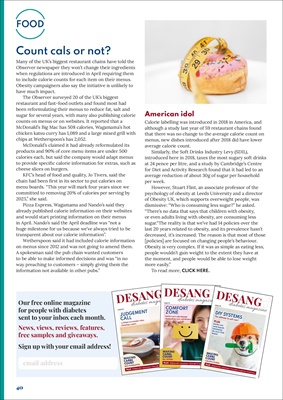
40
FOOD
Count cals or not?
Many of the UK's biggest restaurant chains have told the
Observer newspaper they won't change their ingredients
when regulations are introduced in April requiring them
to include calorie counts for each item on their menus.
Obesity campaigners also say the initiative is unlikely to
have much impact.
The Observer surveyed 20 of the UK's biggest
restaurant and fast-food outlets and found most had
been reformulating their menus to reduce fat, salt and
sugar for several years, with many also publishing calorie
counts on menus or on websites. It reported that a
McDonald's Big Mac has 508 calories, Wagamama's hot
chicken katsu curry has 1,089 and a large mixed grill with
chips at Wetherspoon's has 2,052.
McDonald's claimed it had already reformulated its
products and 90% of core menu items are under 500
calories each, but said the company would adapt menus
to provide specific calorie information for extras, such as
cheese slices on burgers.
KFC's head of food and quality, Jo Tivers, said the
chain had been first in its sector to put calories on
menu boards. "This year will mark four years since we
committed to removing 20% of calories per serving by
2025," she said.
Pizza Express, Wagamama and Nando's said they
already published calorie information on their websites
and would start printing information on their menus
in April. Nando's said the April deadline was "not a
huge milestone for us because we've always tried to be
transparent about our calorie information".
Wetherspoon said it had included calorie information
on menus since 2012 and was not going to amend them.
A spokesman said the pub chain wanted customers
to be able to make informed decisions and was "in no
way preaching to customers - simply giving them the
information not available in other pubs."
Our free online magazine
for people with diabetes
sent to your inbox each month.
News, views, reviews, features,
free samples and giveaways.
Sign up with your email address!
ISSUE 115
MAKING
CARBS
COUNT
MILK ALTERNATIVES
PLUS Diabetes kit • Giveaways • News (for T1 and T2) • Food News
JUDGEMENT
CALL
10 things to consider when
choosing a meter
PLUS
Who's Zooming who?
An update on digital
health delivery
ISSUE 111
MAKING
CARBS
COUNT
BELL PEPPERS
PLUS Diabetes kit • Giveaways • News (for T1 and T2) • Food News
COMFORT
ZONE
Roche's new micropump:
designed for user satisfaction
PLUS
Dexcom's next
generation G7 sensor ISSUE 119
MAKING
CARBS
COUNT
LUSCIOUS LYCHEES
PLUS Diabetes kit • Giveaways • News (for T1 and T2) • Food News
DIY SYSTEMS
The ultimate in self-care?
PLUS
Roche's new
meter launch:
introducing
the Accu-Chek
Instant
email address
American idol
Calorie labelling was introduced in 2018 in America, and
although a study last year of 59 restaurant chains found
that there was no change to the average calorie count on
menus, new dishes introduced after 2018 did have lower
average calorie count.
Similarly, the Soft Drinks Industry Levy (SDIL),
introduced here in 2018, taxes the most sugary soft drinks
at 24 pence per litre, and a study by Cambridge's Centre
for Diet and Activity Research found that it had led to an
average reduction of about 30g of sugar per household
per week.
However, Stuart Flint, an associate professor of the
psychology of obesity at Leeds University and a director
of Obesity UK, which supports overweight people, was
dismissive: "Who is consuming less sugar?" he asked.
"There's no data that says that children with obesity,
or even adults living with obesity, are consuming less
sugar."The reality is that we've had 14 policies over the
last 20 years related to obesity, and its prevalence hasn't
decreased, it's increased. The reason is that most of those
[policies] are focused on changing people's behaviour.
Obesity is very complex. If it was as simple as eating less,
people wouldn't gain weight to the extent they have at
the moment, and people would be able to lose weight
more easily."
To read more, CLICK HERE.